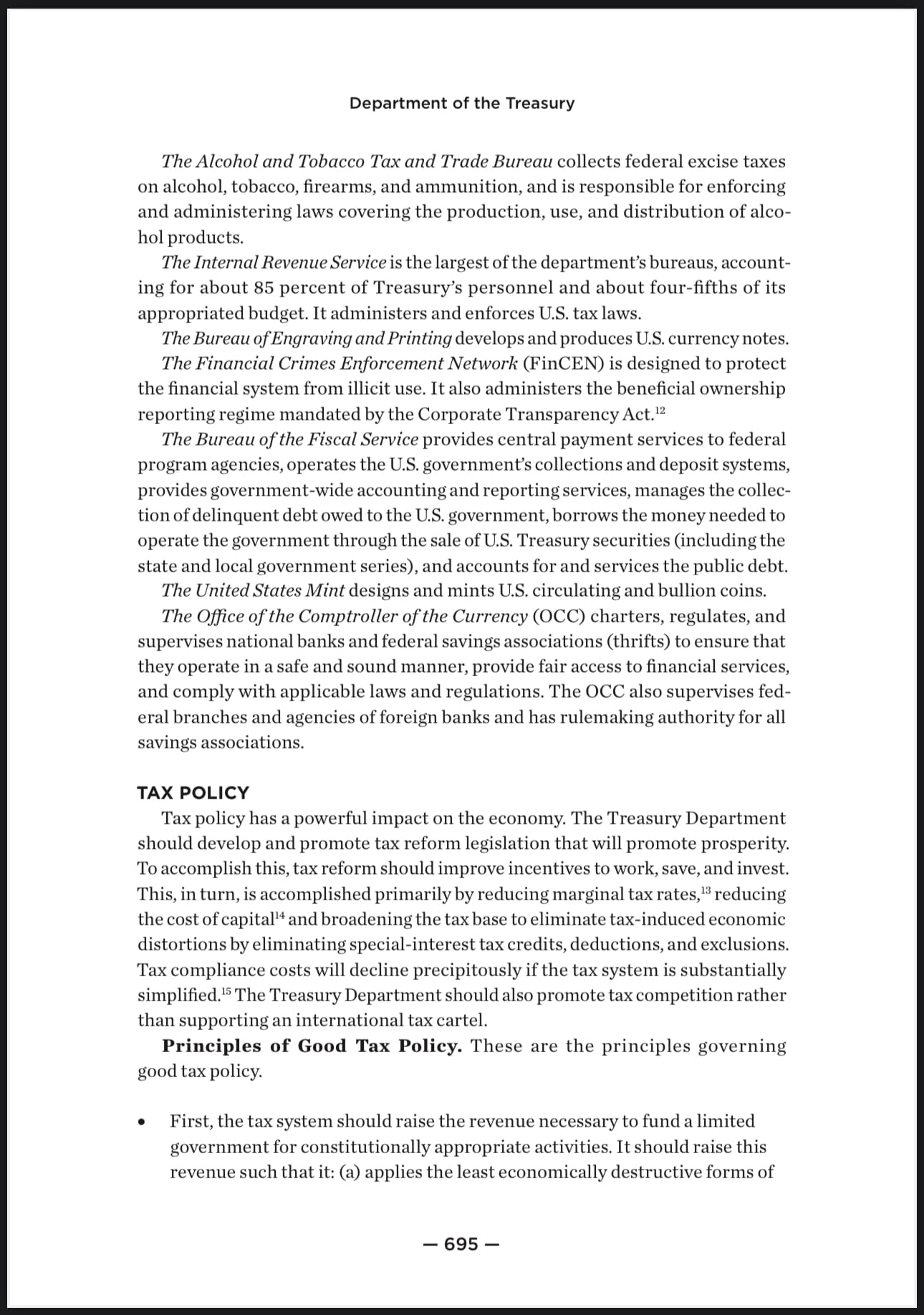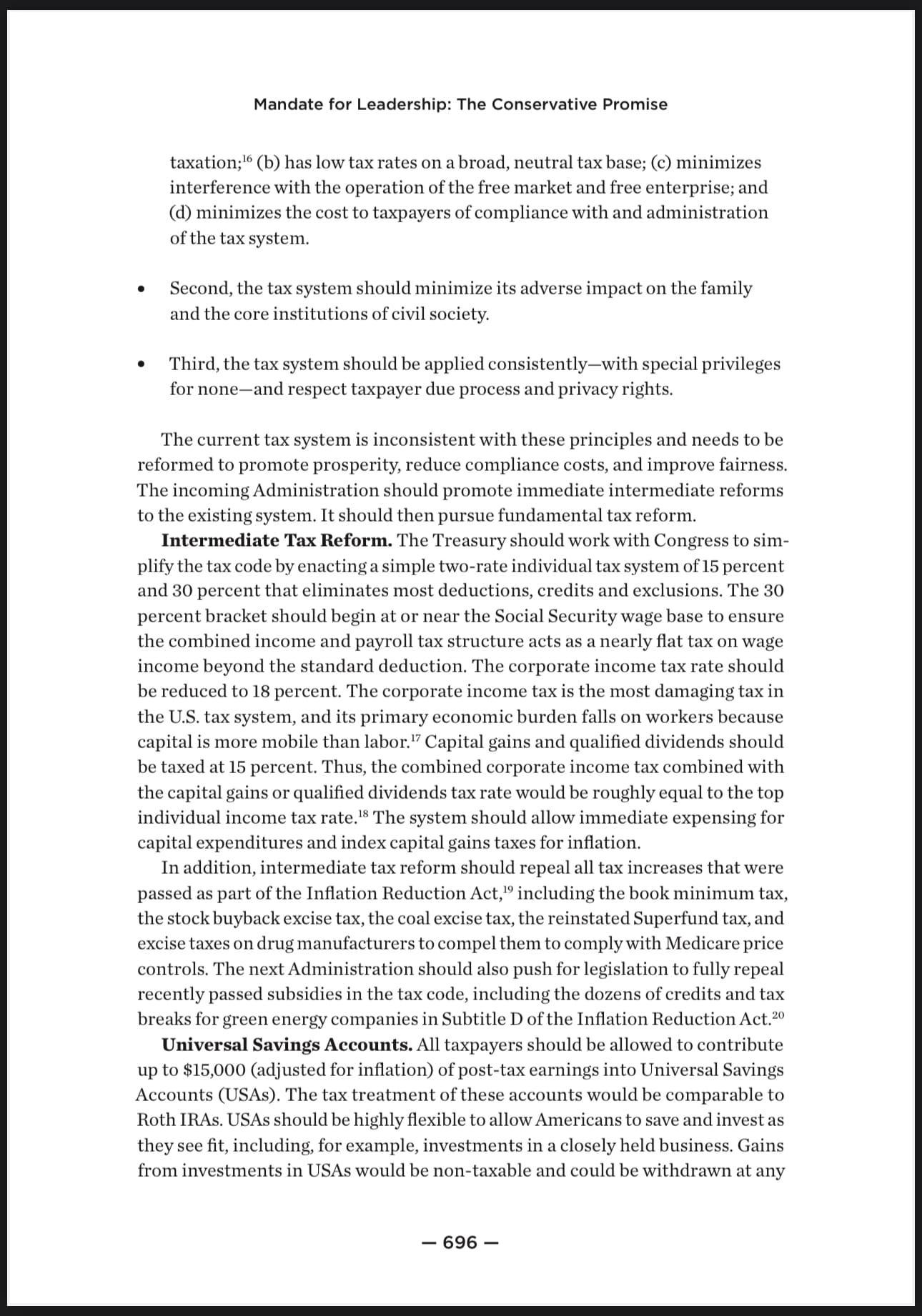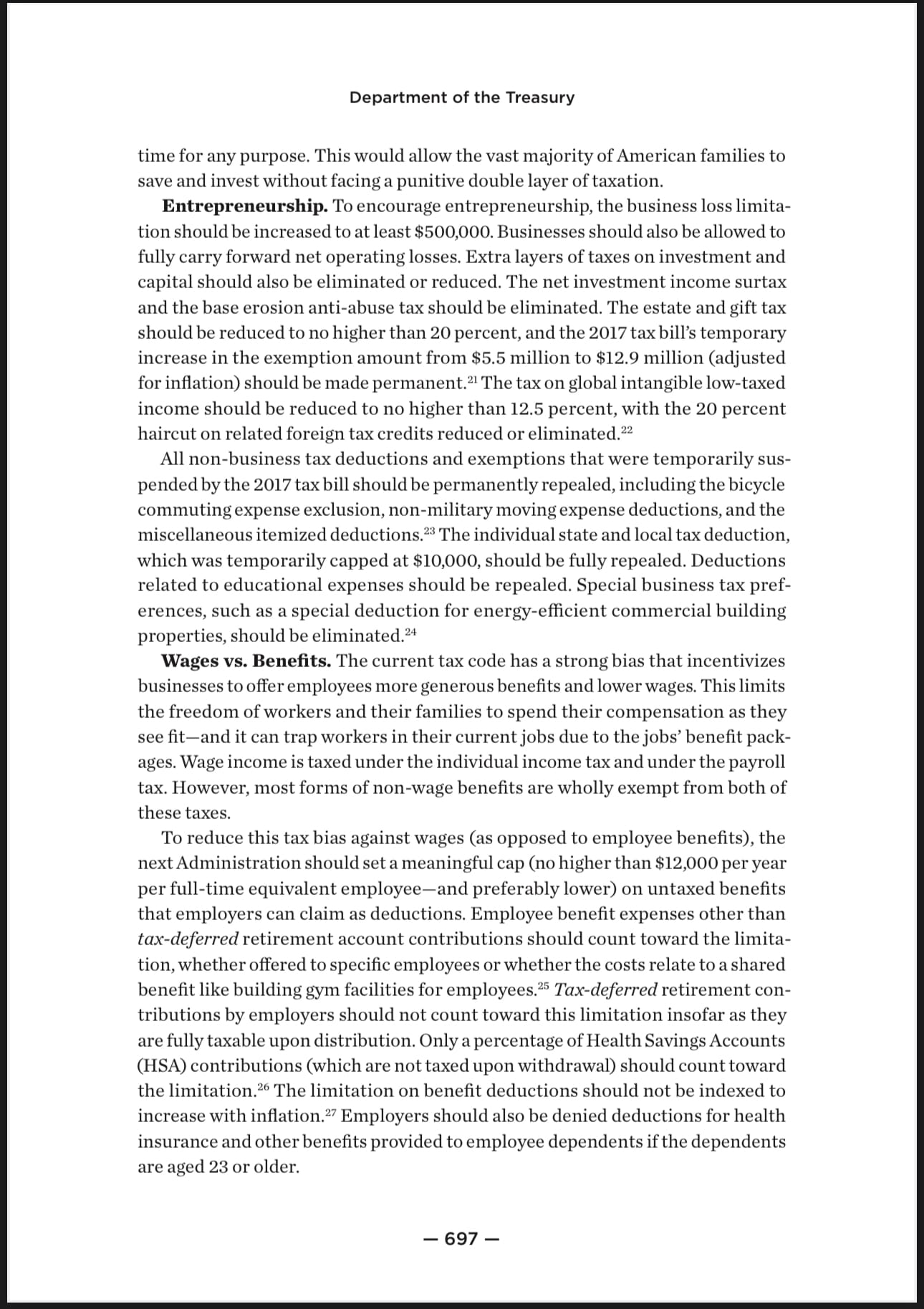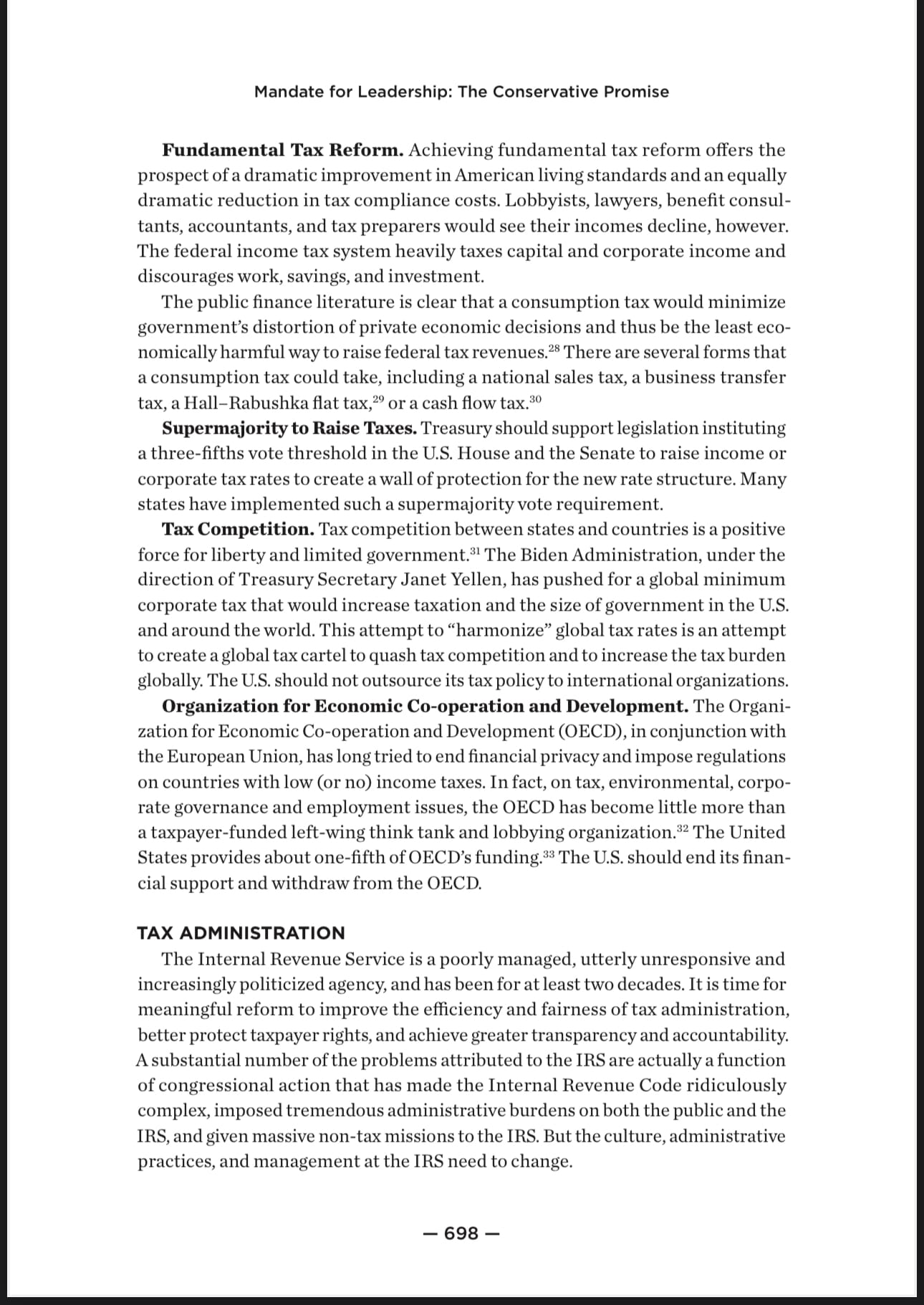TAX

Based on the text extracted from the four images, the proposed Tax Policy under Project 2025 (which seems aligned with a potential second Trump administration) outlines several significant shifts and reforms. Here’s an analysis of the potential consequences and differences from Trump’s first term in office:




Tax Policy under Project 2025
Key Aspects of Project 2025 Tax Policy
1. Tax System Reforms:
• The policy suggests tax reforms aimed at increasing prosperity, lowering compliance costs, and enhancing fairness. This would include broadening the tax base, reducing marginal tax rates, and eliminating economic distortions caused by special-interest tax credits, deductions, and exclusions.
• Simplification of the tax code, such as the implementation of a two-rate individual tax system with rates of 15% and 30%. This could eliminate most deductions, credits, and exclusions, making the tax system simpler but potentially less progressive.
2. Corporate Taxation:
• A significant focus is on reducing the corporate income tax rate from the current level (21%) to 18%, maintaining that corporate tax is damaging because of its burden on workers, as capital is more mobile than labor. It also proposes that capital gains and dividends be taxed at 15%.
• The proposal to align corporate and individual capital gains tax rates with the highest personal income tax rate aims to remove tax preferences for certain types of income.
3. Universal Savings Accounts:
• The policy suggests the introduction of Universal Savings Accounts (USAs), which would allow Americans to invest and save up to $15,000 annually without facing tax penalties. Withdrawals would also be non-taxable. This is a continuation of the emphasis on incentivizing savings and investments seen in Trump’s earlier policies, but it formalizes and potentially expands these incentives.
4. Repeal of Inflation Reduction Act Provisions:
• The policy advocates repealing several taxes imposed under the Inflation Reduction Act, including the book minimum tax and excise taxes such as the stock buyback tax and coal excise tax. This is aligned with a deregulatory approach, focused on reducing the tax burden on corporations and specific industries.
5. Entrepreneurship and Investment:
• The policy intends to encourage entrepreneurship by increasing the business loss limitation threshold to $500,000 and allowing businesses to fully carry forward net operating losses. The proposal also aims to eliminate certain layers of taxation on investment and capital and repeals taxes such as the net investment income surtax.
6. Estate and Gift Taxes:
• Estate and gift taxes would be permanently reduced, with higher exemption amounts and the potential for these taxes to be fully eliminated. The estate tax reduction (initially pursued under Trump’s 2017 Tax Cuts and Jobs Act) would be made permanent, and additional cuts would reduce tax burdens further.
Consequences of the Proposed Tax Policy:
• Economic Impact:
• The policy is heavily focused on reducing taxes for corporations, investors, and high-net-worth individuals. While this could spur investment and economic growth, critics might argue that it could exacerbate inequality by providing more benefits to the wealthy than to lower- or middle-income earners.
• By lowering corporate taxes and capital gains taxes, the policy aims to reduce the cost of capital, encouraging businesses to invest. However, such cuts could also increase deficits unless offset by cuts in spending or other revenue-raising measures.
• Simplicity vs. Progressivity:
• The shift towards a simpler tax system, with fewer deductions and credits, could make tax filing easier but might reduce the progressivity of the tax system. Special deductions and credits often benefit specific groups, and their elimination could mean that middle-income and lower-income individuals may lose out on targeted tax relief.
• Global Tax Competition:
• The policy is opposed to global tax harmonization efforts like those pushed by the OECD. It rejects global minimum corporate taxes, emphasizing tax competition as a way to maintain U.S. sovereignty and competitiveness. This could lead to increased tension between the U.S. and other nations pursuing international tax cooperation.
• Wages vs. Benefits:
• A cap would be placed on tax-exempt non-wage benefits, limiting the amount that can be deducted for benefits like health insurance or gym facilities. This might push employers to provide more direct wage compensation rather than tax-advantaged benefits.
Comparison to Trump’s First Term:
1. Continuation of 2017 Tax Cuts and Jobs Act:
• The proposed tax policy under Project 2025 builds upon the 2017 Tax Cuts and Jobs Act (TCJA), which slashed corporate tax rates from 35% to 21%. The further reduction to 18% continues this trend, but it represents an even more aggressive lowering of corporate taxes.
• Many of the proposed reforms aim to solidify and expand the tax cuts made during Trump’s first term, such as making the estate tax cuts permanent and lowering individual tax rates further.
2. New Repeals and Simplifications:
• One difference from the first term is the proposal to repeal taxes imposed by the Inflation Reduction Act, which wasn’t in place during Trump’s earlier administration. The focus on eliminating taxes on capital gains and investments is an extension of the first term’s tax-cutting policies but takes it further by streamlining capital-related taxes and aligning them with individual rates.
3. More Focus on Reducing Tax Complexity:
• There’s a greater emphasis on tax simplification in Project 2025, which might have been learned from the complications and criticisms that arose with the TCJA. The focus on implementing a flatter, two-bracket individual tax system shows a shift towards simplifying the tax code more aggressively than was done during the first term.
In summary, Project 2025’s tax policy aligns with the broader themes of Trump’s first term—lowering taxes, reducing regulations, and encouraging investment—but it proposes more radical simplifications and repeals, especially targeting taxes implemented after the 2021 Biden administration’s policies. The impact on economic growth, investment, and the fiscal deficit would be significant points of debate.